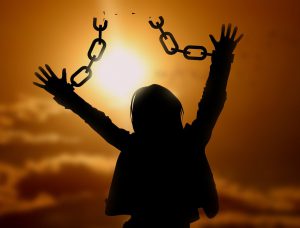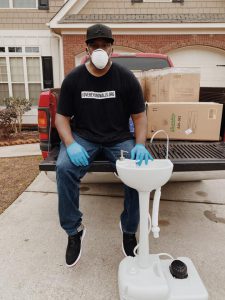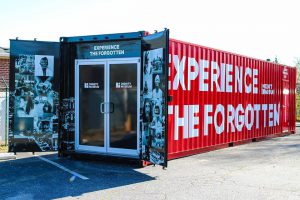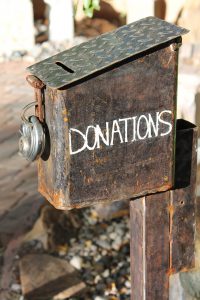According to Ebony Underwood, founder and CEO of the organization We Got Us Now, there is an “invisible population” that is being traumatized by the prison system in the United States. She’s not referring to the nearly 2.3 million people who are currently incarcerated, she’s talking about their children, and the children of formerly incarcerated people. These children suffer from a confusing mix of sadness, shame, and anger, which Underwood understands all too well – her father is imprisoned for life and it has taken her years to be able to speak about it.

Her organization aims to give these children a voice and put them at the center of discussions about criminal justice reform. We Got Us Now is built and led by children of incarcerated parents, and its mission is to “engage, educate, elevate, and empower through the use of digital narratives, safe-spaces and advocacy-led campaigns” that highlight and push for more humane policies surrounding the treatment of families in the prison population.
“Our stories are often unknown and untold,” says the organization’s website, “our experiences are unheard.” We Got Us Now is trying to change that.
“The Collateral Consequences of Mass Incarceration”
To understand why Ebony Underwood does what she does, it’s important to know about the population she’s fighting for. 1 in every 28 children in the U.S. has an incarcerated parent, and approximately 10 million children have had an incarcerated parent at some point in their lives. “But,” said Ebony Underwood, “these children often do not share this part of their lives because of the shame, stigma, and trauma attached to the experience.” For Underwood, living without her father and the uncertainty of when and if he would return meant that she “just stuffed the emotional turmoil of his physical absence deep down inside of me to avoid the pain.”

Children often experience these feelings and have trouble expressing them, just as Underwood did. In “Collateral Damage,” an exhibition on children with incarcerated parents by the NGO group for the Committee on the Rights of the Child, the children of incarcerated parents often describe themselves as both “sad” and “angry.” One girl said, “I hated my mom…I thought she didn’t love us. But I also missed her.” Some said they’d rather not talk about it at school because they’re scared of what their friends will say, or that they want to keep it a secret from everybody.
Children of incarcerated parents are not only dealing with emotional pain, they also often live in poverty and destabilized family situations. Because of this, they are 6 times more likely to become incarcerated themselves. “But it’s not that parental incarceration causes children to end up incarcerated. It really is about economics,” said Underwood. “People think because your parent is incarcerated, you’re going to end up there — but no, poverty is at the basis of why you might end up incarcerated.”
“There Is a Name for What I’ve Experienced”
Ebony Underwood grew up in that reality of confusing emotions, silent suffering, and scary statistics. In 1988, when she was just 13, her father, William, was arrested on drug-related charges and given life without parole. It was his first offense, but he was sentenced based on controversial mandatory minimum laws. “He’s been incarcerated for 30 years and it feels so heavy — like we’re literally attached to him [with a] ball and chain,” said Underwood.
Despite his imprisonment, Underwood’s father has been very present in her life. She said: “My father has never once stopped being a father. He has been a very consistent parent, and he’s been fighting, fighting for so long to just come back into our lives: not just phone calls once a week, I mean every day. Whether we answered the phone or not, he kept calling. Graduation cards every year, holiday cards every year… My passion, my love for my dad and my family [brought me into this effort].”

When the Obama administration began granting clemency to some prisoners, Underwood began campaigning for the release of her father. Her efforts were not successful, but something good still came out of her contact with the Obama administration. In 2014, she learned of a White House initiative for “children of incarcerated parents.” Said Underwood: “I was shocked because not only had I never heard this term before, but I also did not know anyone actually cared about the children of people behind bars. That moment led me to create We Got Us Now.”
At that moment, her efforts became about more than just her love for her family and her desire for her son to have a relationship with his grandfather. “I realized that the story was way greater than my own,” she said. “Mass incarceration is a tsunami that has ripped across the country and destroyed communities and ripped apart families.”
“We Will No Longer Be Silenced by our Pain”
Ultimately, Ebony Underwood doesn’t believe that children of incarcerated parents are destined to be incarcerated themselves. “And that’s why I say: We got us now,” she explained. “Ultimately we have to tell people, and show people who we are, instead of people telling us who we are. We are survivors, not victims of this experience.”

She has been working hard to tell these stories since 2014, when she began speaking publicly and sharing her story through film, television, writing, and social media advocacy. In 2016, she formally started We Got Us Now, and continued conducting campaigns to advocate for children of incarcerated parents. For example the group’s “Love Letters” campaign allows children to send YouTube messages to their parents for Mother’s or Father’s Day.
We Got Us Now is about storytelling, but also about building a community of people impacted by parental incarceration, and about action. The organization brings together and trains actionists – who are children of incarcerated parents – to become advocates for others like them. They fight for legislation that would make it easier for families to stay connected, like proposed laws in New York that would mandate free transportation to correctional facilities for families on a bi-montly basis and would require that parents be incarcerated in the facility closest to their families. We Got Us Now is also pushing for legislation that would ban facilities charging exorbitant rates for phone calls. According to studies, all of these policies would help reduce trauma on children, and even reduce recidivism rates in incarcerated parents.
“We’re going to ensure that our voices are at the forefront of practices and policies that continue to impact us,” said Ebony Underwood. “We want to keep families connected and ultimately we would love to be able to end mass incarceration because we do not need another generation experiencing that.”
How You Can Help
If you want to help We Got Us Now, you can donate via their website. You can offer your skills to the organization by signing up to “join the movement” – you do not need to be the child of an incarcerated person to support them! They also highlight petitions you can sign – again, check out their website for information. You can also read up on what policy proposals there are in your area and sign any petitions supporting them. And, of course, you can call your senator and representative to push for reforms that would benefit children of incarcerated parents. Mass incarceration is not someone else’s problem, it affects all of our society. And, as Ebony Underwood points out, “children are innocent bystanders of this experience.”









